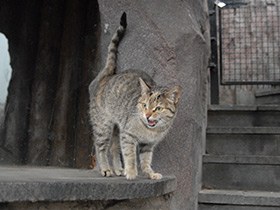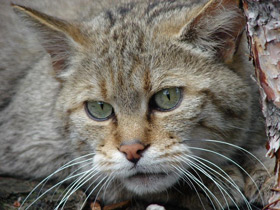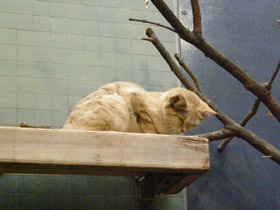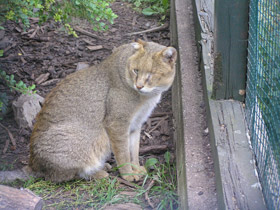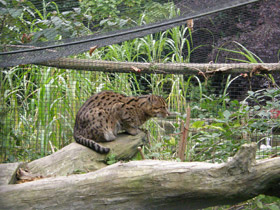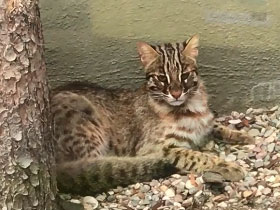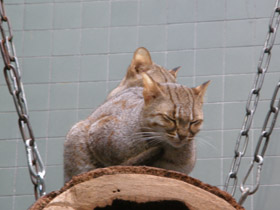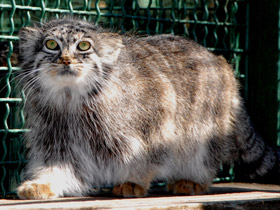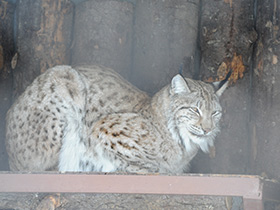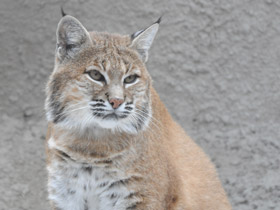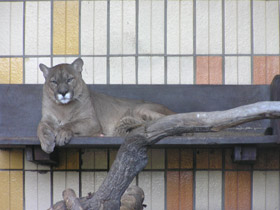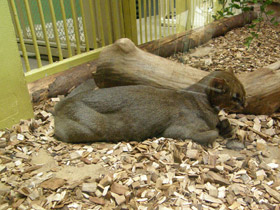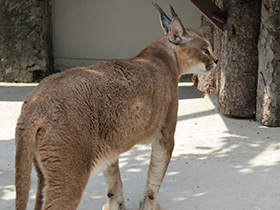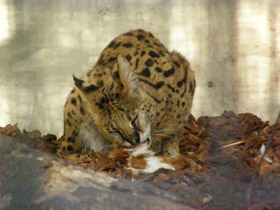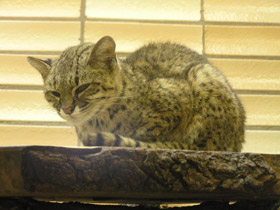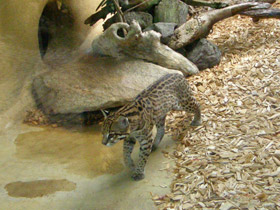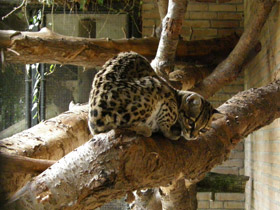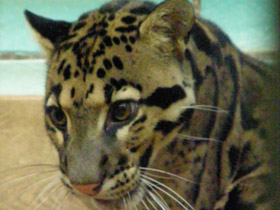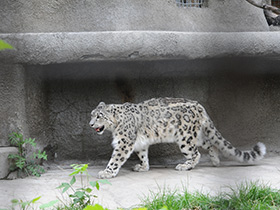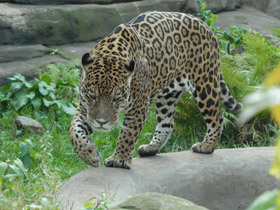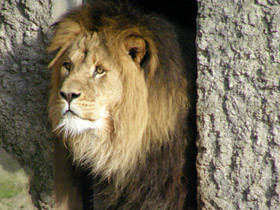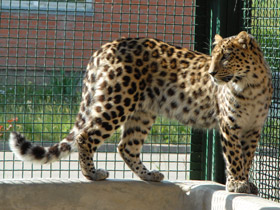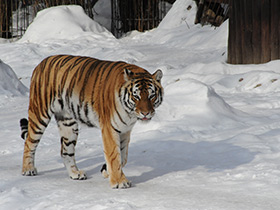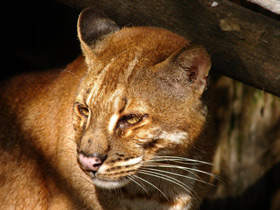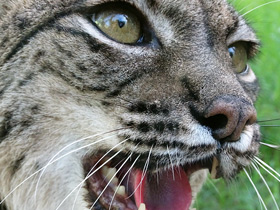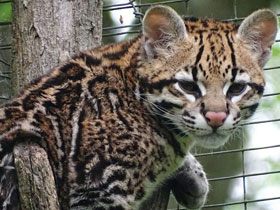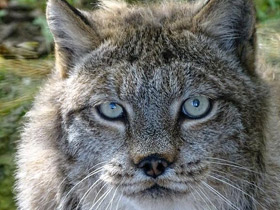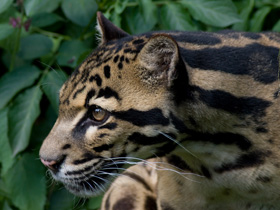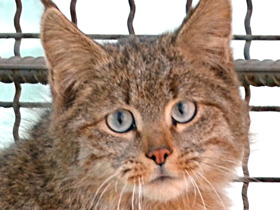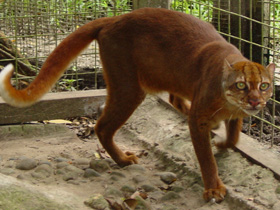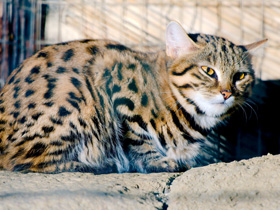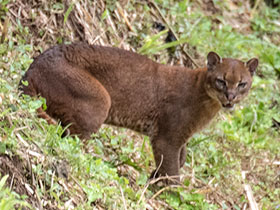The family Felidae
2. European wildcat
3. Sand cat
4. Gungle cat
5. Fishing cat
6. Leopard cat
7. Rusty-spotted cat
8. Pallas's cat
9. Balkan lynx
9-а. Iberian lynx
10. Bobcat
11. Cougar
12. Jaguarundi
13. Cheetah
14. Caracal
15. Serval
16. Geoffroy's cat
17. Ocelot
18. Margay
19. Clouded leopard
20. Snow leopard
21. Jaguar
22. Lion
23. Leopard
24. Tiger
25. African golden cat
26. Oncilla
27. Canada lynx
Felids are most specialized and perfect predators of all carnivores. Many features of the body structure of these gracious creatures evolved as adaptations for hunting alive prey. Long scaring canines and curved, sharp, pointed claws serve as a weapon for grabbing and killing a prey. The claws are retractable which keeps them sharp and protects them from being worn down when the animal is running; special ligaments prevent the claws from going out when the animal is walking or running, and let them protract when it is attacking its prey. However, due to the structure of their limbs, felids can not chase their prey at a high speed – but they do not need it! Wild cats usually attack their prey by ambushing or stalking their victim and overtaking it in two or three leaps. And they are brilliant jumpers, indeed! Felids have extremely flexible bodies, and their back limbs are stronger and longer than the front ones which feature allows them to push off the ground with great strength and jump from a standing start. Striped or spotted color patterns on their coats provide felids with perfect camouflage enabling them to blend into the grass or shadows of the tree branches in the forest. Felids have excellent sense of hearing and quite good color vision; besides, many species are nocturnal and can see in the dark. However, their sense of smell is not so good, and they do not often rely on it while hunting or looking for prey. The tongue of these carnivores is covered with small, horny papillae which help the animals to hold their food, rasp meat from the bones and groom themselves. Most of the species feature a long tail which perfectly helps the cat to keep its balance. Babies of all felids are blind and helpless at birth, and usually the mother takes care of her offspring while fathers do it only occasionally.
The family consists of 37 species (including domestic cat) inhabiting five continents.
Felidae (/ˈfɛlɪdiː/) is the family of mammals in the order Carnivora colloquially referred to as cats. A member of this family is also called a felid (/ˈfiːlɪd/). The term "cat" refers both to felids in general and specifically to the domestic cat (Felis catus).
Felids or commonly called felids (Felidae) are a family of placental mammals of the order Carnivora.
Felids are the most specialised and sophisticated of all modern predators. Many features of the body structure of these graceful animals are adaptations for hunting live prey.
Long, fearsome tusks and curved, sabre-sharp claws are weapons for grasping and killing. The claws must always be sharp and not graze the ground while running, so they are retracted; special ligaments keep them retracted while walking and release them when attacking prey.
It is true that this limb structure does not allow felids to chase their prey at high speed for a long time. But they don't need to; after all, felids usually ambush or sneak up on their prey and catch them in two or three jumps. And they are great jumpers!
Felids have a very flexible body and strong, long hind legs that give them a powerful kick and allow them to leap from a standing position without the need to hop. Their patchy or striped colouration makes them camouflage well in the grass or under branches in the forest.
Felids have extremely acute hearing and excellent stereoscopic colour vision, and can also see in the dark. Their sense of smell, on the other hand, is weak and is hardly used for hunting and finding prey.
The tongue of these raptors is covered with tiny, pointed, horny papillae, which help to grip food, scrape flesh from bones and brush fur.
The tail of most species is long and serves as an excellent balancer when moving. All felids have young that are born blind and helpless; they are raised by their mother and are rarely cared for by their father.
The family includes 37 species, including the domestic cat (Felis silvestris catus), on five continents.
Classification
Traditionally, five subfamilies had been distinguished within the Felidae based on phenotypical features: the Pantherinae, the Felinae, the Acinonychinae, and the extinct Machairodontinae and Proailurinae. Acinonychinae used to only contain the genus Acinonyx but this genus is now within the Felinae subfamily.
- Family Felidae:
- Subfamily Felinae:
- Genus Acinonyx:
- Acinonyx jubatus – Cheetah;
- Genus Caracal:
- Caracal caracal - Caracal (misnamed African lynx, as it is not related to the genus Lynx);
- Caracal aurata - African golden cat;
- Genus Catopuma:
- Catopuma badia - Bornean Red Cat;
- Catopuma temminckii - Asian Golden Cat;
- Genus Felis:
- Felis bieti - Chinese desert cat or Chinese wildcat; IUCN considers it a subspecies of Felis silvestris (Felis silvestris bieti);
- Felis catus - Domestic cat; IUCN considers it to be a subspecies of Felis silvestris (Felis silvestris catus);
- Felis chaus - Jungle cat, jungle cat, or swamp cat;
- Felis margarita - Desert cat;
- Felis nigripes - Black-footed cat;
- Felis silvestris - Eurasian wildcat;
- Genus Leopardus:
- Leopardus colocolo - Colocolo cat;
- Leopardus geoffroyi - South American Bobcat or Geoffroy's Cat;
- Leopardus guigna - Kodkod or huiña;
- Leopardus jacobita - Andean cat or Andean cat;
- Leopardus pardalis – ocelot;
- Leopardus tigrinus - Tiger leopard;
- Leopardus wiedii - Tigrillo, margay or tiger cat;
- Genus Leptailurus:
- Leptailurus serval – Serval;
- Genus Lynx:
- Lynx canadensis - Canada lynx;
- Lynx lynx - Boreal lynx;
- Lynx pardinus - Iberian lynx;
- Lynx rufus - North American bobcat;
- Genus Otocolobus:
- Otocolobus manul - Manul cat;
- Genus Pardofelis:
- Pardofelis marmorata - Marbled cat;
- Genus Prionailurus:
- Prionailurus bengalensis - Bengal cat or leopard cat;
- Prionailurus iriomotensis - Iriomote cat;
- Prionailurus planiceps - Flat-headed cat;
- Prionailurus rubiginosus - Red-spotted cat;
- Prionailurus viverrinus - Fishing cat;
- Genus Puma:
- Puma concolor – Puma;
- Puma yagouaroundi - Jaguarundi or otter cat;
- Subfamily Pantherinae:
- Genus Neofelis:
- Neofelis nebulosa - Clouded panther or clouded leopard;
- Neofelis diardi - Bornean clouded panther or Bornean clouded leopard;
- Genus Panthera:
- Panthera leo – Lion;
- Panthera onca – Jaguar;
- Panthera pardus – Leopard;
- Panthera tigris – Tiger;
- Panthera uncia - Snow leopard or irbis;
- Subfamily Machairodontinae †;
- Subfamily Proailurinae †.
In addition, there are many other extinct genera, such as:
- Abelia;
- Adelphailurus;
- Asilifelis Werdelin, 2011 (Burdigalian of Africa);
- Diamantofelis Morales et al., 1998 (Burdigalian of Africa);
- Dinofelis;
- Dolichofelis;
- Dromopanthera;
- Jansofelis;
- Leontoceryx;
- Metailurus;
- Miracinonyx;
- Namafelis Morales et al., 2003 (Burdigaliense of Africa);
- Nimravides;
- Pikermia;
- Pratifelis;
- Proailurus;
- Pseudaelurus;
- Schaubia;
- Sivaelurus;
- Sivapanthera;
- Sivapardus;
- Vishnufelis.
Large felids
The five largest current species of the family are, in this order: tiger, lion, jaguar, puma and leopard.
They are generally fast (cheetah: 108 km/h; tiger: 80 km/h; puma: 70 km/h; leopard: 60 km/h and lion: 50 km/h) and strong hunters.

















